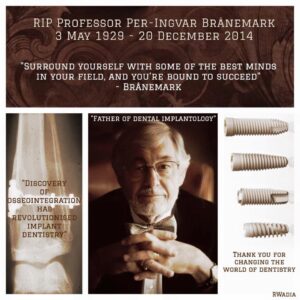
If you ever went searching for your car keys but found a $100 bill instead, you might feel a little like Dr. Per-Ingvar Brånemark. He was looking into how blood flow affects bone healing—and he ended up discovering osseointegration.
Better osseointegration is one of our primary goals at Himed. When we develop surface treatments and coatings, we do it with the aim of improving the integration of implants with a patient’s bones. The very phrase “osseointegration” was coined by Dr. Brånemark, who is now considered the father of the modern dental implant. Before his work, the medical community was pretty sure that such a thing wasn’t even possible.
Rabbit legs
Swedish physician, anatomy professor, and medical researcher Dr. Per-Ingvar Brånemark was working with rabbits in 1952, attempting to study blood flow as it relates to bone healing. By implanting a specially modified microscope into the leg bones of rabbits, Brånemark and his team were able to see how microcirculation in bone tissue aided healing—from the inside out.
After collecting the data they needed, it was time for Brånemark and his team to remove the optical devices from the rabbits’ leg bones. Except they couldn’t. The bones had fused to the casing surrounding the optical devices.
The material for the casing? Titanium.
A hard road towards acceptance
Up to that point, the common belief in the medical community was that the body would eventually reject any implanted foreign object. The idea that bone would actually fuse and grow into an implant was unheard of, and frankly disbelieved.
Brånemark knew what he had discovered was groundbreaking, with wide-ranging potential. He quickly switched his focus to dive deeper into the possibilities of the process he termed osseointegration.
But the medical community wasn’t as enthusiastic about his discovery. Despite first discovering osseointegration in the early 1950s, it wasn’t until years later, after numerous rejections, that he finally received funding in the form of a grant from the United States National Institutes of Health.
Not that lack of support or major funding dampened his efforts.
A wildly successful test case
By 1965, Brånemark had verified that titanium was indeed compatible within the human body—by testing it on his own lab students. About 20 medical students working in his lab had a small piece of titanium inserted into their upper arms—with no ill effects.
So in 1965, Brånemark performed an operation using titanium dental implants he and his team developed. The patient receiving the implants suffered from a cleft palate and jaw deformities that left him with no teeth in his lower jaw. The operation fixed four implants into the patient’s jaw, allowing for the use of compatible dentures. The implants developed no complications and stayed in place for four decades, proving effective up to the point of the patient’s death.
Yet another serendipitous discovery
As part of his research into oral titanium implants, Brånemark and his team needed to verify that implants were actually integrated into the bone, and not just mechanically anchored. They tested the osseointegration by applying a high-frequency vibration to a patient’s implant.
One particular patient happened to suffer from hearing loss, yet he was able to hear the high-frequency of the vibrations. Brånemark concluded that the patient’s bones were conducting sound.
A member of Brånemark’s research team, PhD student Anders Tjellström, followed Brånemark’s suggestion that a titanium implant in the bone behind the ear could act as a kind of hearing aid. Tjellström went on to perform the first bone conduction implant surgery, restoring hearing to a patient who had struggled with hearing loss for thirty years.
From skepticism to millions of implants
Thanks to Brånemark’s tireless work, continuing with his research even when the majority of the medical community did not believe in his discoveries, osseointegration of implants is now commonplace.
Finally in 1970, Sweden’s National Board of Health and Welfare approved Brånemark’s dental implants. Brånemark received European and US patents for his system of titanium implants. And today, the biomedical company he formed in Sweden in 1981 still markets and sells the Brånemark System®.
Of course titanium implants are now used in implants throughout the body, helping patients throughout the world. Here at Himed, our processes and surface treatments for implants build on Brånemark’s discovery nearly 70 years ago. Without Dr. Brånemark and his unexpected discovery, titanium’s ability to bond with our bones may never have been known. It’s a pretty great narrative to keep in mind when you’re looking for one thing, but find something else entirely.
Reference Source:
www.himed.com

